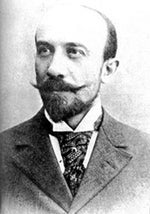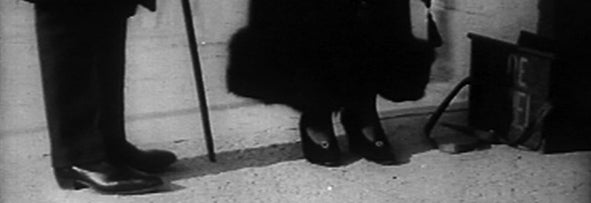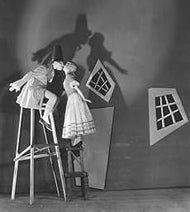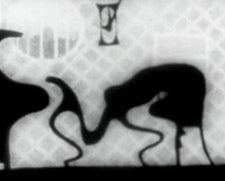My first night in Paris, Serge Bromberg of Lobster Films invited me to a program of silent shorts at the auditorium of the Louvre. Not realizing that the Louvre had a film program (curated by Pascale Raynaud), and not just the Mona Lisa and the Venus de Milo, my daughter and I overcame our jetlag and took the Metro to the Louvre. The relatively short, but sold-out program was in fact a classic French mélange of early cinema, documentary, and avant-garde, as had been programmed at the Studio des Ursulines in Paris in the late 1920s. The films had been chosen by Ibrahim Maalouf, a French jazz trumpeter who improvised the music with ten of his music students from the Pôle Supérieur d’enseignement artistique des Paris Boulogne-Billancourt. Maalouf, who doesn’t look a whole lot older than his students, created an interesting mixture of jazz, modern atonal and North African sounds, which worked well for most of the films, but seemed a bit too diffuse for others.
 First up was Georges Méliès’ Le Tunnel sous la Manche (1907), which imagines a tunnel under the English channel between Dover and Calais eighty-seven years before the Chunnnel opened in 1994. The print was initially very badly scratched and at times even difficult to see, but then switched to a nearly pristine hand-colored print, which revealed Méliès’ wonderful sense of humor. Thus, the opening ceremonies for the completed tunnel give rise to overblown nationalist speeches and ceremonies on both the French and British sides and an endless parade of officials, workers, and women. I realized again how densely the director constructed his mise-en-scene with action filling virtually every corner of the frame. Later in the program we saw Méliès’ Éclipse de soleil en pleine lune (1907), which uses a solar eclipse to imply a gay sex act, since the nominally “female” moon has an unmistakably male face. This may have been a nod to the fact that France legalized gay marriage six days before the screening (Two days later, we witnessed massive anti-gay demonstrations of the “family-oriented” right down the Avenue Saint Germain des Pres on the Left Bank).
First up was Georges Méliès’ Le Tunnel sous la Manche (1907), which imagines a tunnel under the English channel between Dover and Calais eighty-seven years before the Chunnnel opened in 1994. The print was initially very badly scratched and at times even difficult to see, but then switched to a nearly pristine hand-colored print, which revealed Méliès’ wonderful sense of humor. Thus, the opening ceremonies for the completed tunnel give rise to overblown nationalist speeches and ceremonies on both the French and British sides and an endless parade of officials, workers, and women. I realized again how densely the director constructed his mise-en-scene with action filling virtually every corner of the frame. Later in the program we saw Méliès’ Éclipse de soleil en pleine lune (1907), which uses a solar eclipse to imply a gay sex act, since the nominally “female” moon has an unmistakably male face. This may have been a nod to the fact that France legalized gay marriage six days before the screening (Two days later, we witnessed massive anti-gay demonstrations of the “family-oriented” right down the Avenue Saint Germain des Pres on the Left Bank).

I knew what to expect with Méliès, but the next film was a real discovery for me: Amor pedestre (1914), an Italian film by Marcel Perez, alias Marcel Fabre. The film focuses solely on the feet of its protagonists to visualize an almost clichéd melodrama: man follows married woman, who is apparently interested, husband finds note, a duel ensues during which the would-be lover is wounded, lover is rewarded when wife leaves her husband. The last shot has the woman drop her dress for him and you know what. We never see faces, just shoes and legs, and yet the narrative is perfectly clear, despite its extremely limited p.o.v. Serge mentioned to me that Jacques Feyder made a similar film two years later, Des pieds et des mains (1916), which I would love to see some time. I did find a beautifully tinted print on YouTube of Fabre’s film: https://www.youtube.com/watch?v=tD7TOydChZ0.
 Two other films on the program represented the first of the American avant-garde, The Love of Zero (1928), directed by Robert Florey, and Autumn Fire (1933), produced by Herman Weinberg. I have written about both films in my book, Lovers of Cinema. The First American Avant-Garde (1995), but it was great to see them again after twenty years. Florey’s “amateur” film is an expressionist fantasy, complete with Caligari-like costumes and sets, an exaggerated expressionist acting style and elliptical narrative that visualizes the tragic love life of a hopeless romantic, but also quotes numerous German films from the 1920s. When his first love is returned to a Turkish harem, he falls for a prostitute, completely unaware of her profession. The expressionistic sets were made almost exclusively in miniature and photographed with live actors through mirrors, the film costing less than $200, a head title tells us. Florey, of course, went on to make some very quirky Hollywood films, including the truly weird Desert Song (1943), recently “rediscovered” at the TCM Film Fest in L.A.
Two other films on the program represented the first of the American avant-garde, The Love of Zero (1928), directed by Robert Florey, and Autumn Fire (1933), produced by Herman Weinberg. I have written about both films in my book, Lovers of Cinema. The First American Avant-Garde (1995), but it was great to see them again after twenty years. Florey’s “amateur” film is an expressionist fantasy, complete with Caligari-like costumes and sets, an exaggerated expressionist acting style and elliptical narrative that visualizes the tragic love life of a hopeless romantic, but also quotes numerous German films from the 1920s. When his first love is returned to a Turkish harem, he falls for a prostitute, completely unaware of her profession. The expressionistic sets were made almost exclusively in miniature and photographed with live actors through mirrors, the film costing less than $200, a head title tells us. Florey, of course, went on to make some very quirky Hollywood films, including the truly weird Desert Song (1943), recently “rediscovered” at the TCM Film Fest in L.A.
According to Weinberg, the latter film was a romance sentimentale, made as a means of courting a woman he then married, not for public exhibition. The film subjectively portrays two lovers who suffer through their separation, until they are united at the end. Utilizing Russian style montage, Weinberg intercuts continually between the two, juxtaposing their environments, identifying the young woman symbolically with nature and the man with the city (New York). Their reunification in the train station is accompanied by an orgy of flowing water images, an obvious reference to Freudian symbolism for female orgasm. It was here that I thought Maalouf’s music could have been a bit more romantic. By the way, Herman Weinberg went on to be the first film blogger long before the internet: check out his “Coffee, Brandy, and Cigars” in his collected writings, and you will know what I mean.
Osa and Martin Johnson’s very rare travelogue, Journey to the Solomon Islands (1918), reminded me that travelogues, too, were a staple of early avant-garde programming, their view of the ethnic other a subject of fascination for 1920s French intellectuals. Here the American couple who made a career of travelling the globe with a movie camera, frolic with naked South Sea Islanders, before returning to the safe confines of their luxurious yacht.
 The program ended with another discovery, Oskar Fischinger’s Spiritual Constructions (1927), a phantasmagoric animation, in which two males (in silhouette) slowly get drunk at a table, then dissolve into dream-like gyrations in black and white. Unlike the angular abstract animations of contemporary, Walter Ruttmann, Fischinger utilizes art nouveau’s sinuous curves and lines to create a dream-like abstraction that worked very well with Maalouff’s improvised music.
The program ended with another discovery, Oskar Fischinger’s Spiritual Constructions (1927), a phantasmagoric animation, in which two males (in silhouette) slowly get drunk at a table, then dissolve into dream-like gyrations in black and white. Unlike the angular abstract animations of contemporary, Walter Ruttmann, Fischinger utilizes art nouveau’s sinuous curves and lines to create a dream-like abstraction that worked very well with Maalouff’s improvised music.
To close the program, the orchestra gave two improvised encores, which brought the audience to their feet. All in all a great way to start my Parisian vacation.






 Mobile Navigation
Mobile Navigation

